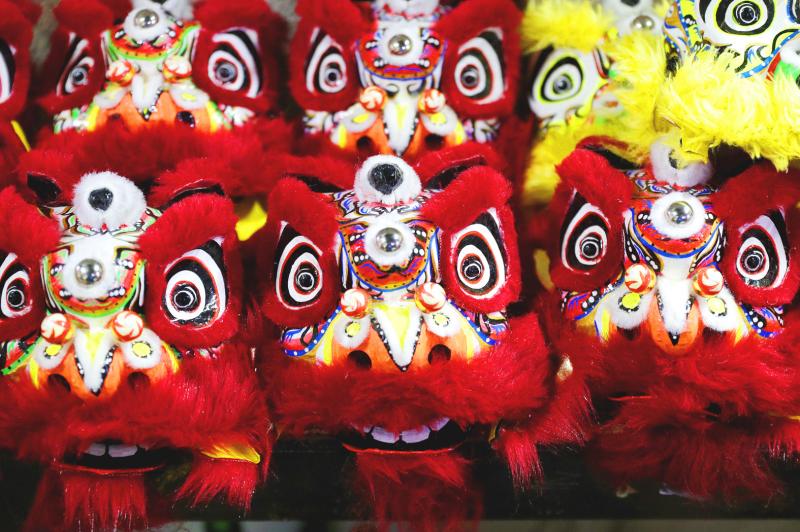Dragon dance shows have been banned in Manila’s Chinatown due to the COVID-19 pandemic, casting aside a crowd-drawing Lunar New Year tradition many believe helps drive misfortunes away.
The Philippine government’s ban on large public gatherings and street parties to fight the coronavirus dealt a big blow to hundreds of dragon dancers and production crews who are struggling to find other sources of income.
“There would have been large crowds wanting to drive away the misery and bad luck, but our street dance shows were prohibited this year,” said Therry Sicat, a Philippine slum-dweller who, with his siblings, manages one of several dragon dance troupes in Chinatown.

Photo: AP
“If we had 100 percent fun in the past, I only feel 30 percent of that this time around. It’s really depressing,” said the 31-year-old, whose wife is pregnant with their fourth child.
The absence of the dragon dances is a palpable sign for many Manila residents that the pandemic that shut down much of Manila’s economy and locked down millions of Filipinos in their homes is spilling over well into this year.
However, Sicat, his siblings and their families are fighting to keep the Chinese tradition — and their livelihood — alive.
After the dragon dances were banned by Manila’s mayor, Sicat and his family used their Styrofoam, paint and other dragon costume-making materials to craft decorative miniature Chinese-style lion heads instead.
The colorful items have become a hit online and fill their small creek-side home with hope and joy. About 200 have been sold so far, priced at 1,500 pesos (US$31) each, he said.
Other members of his dragon dance troupe, which employs about 50 dancers, have set up online food businesses or are working as motorcycle food couriers to make ends meet, Sicat said.
Sicat’s profits from the decorative lion heads are just a fraction of the income generated by their dragon dance shows in the past.
During the busy Lunar New Year season in past years, a Chinatown business establishment would pay 35,000 pesos for a session of dragon and lion dancing accompanied by drummers and merrymakers for good luck.
Sicat still brims with optimism, despite the dire economic times in one of the countries hardest hit by the pandemic in Southeast Asia.
He said he looks forward to the return of the hope-inspiring dragon dances and to hearing the drums again.
“There’s no Chinese New Year, but we are all healthy. We can survive this pandemic,” Sicat said.

Drug lord Jose Adolfo Macias Villamar, alias “Fito,” was Ecuador’s most-wanted fugitive before his arrest on Wednesday, more than a year after he escaped prison from where he commanded the country’s leading criminal gang. The former taxi driver turned crime boss became the prime target of law enforcement early last year after escaping from a prison in the southwestern port of Guayaquil. Ecuadoran President Daniel Noboa’s government released “wanted” posters with images of his face and offered US$1 million for information leading to his capture. In a country plagued by crime, members of Fito’s gang, Los Choneros, have responded with violence, using car

Canada and the EU on Monday signed a defense and security pact as the transatlantic partners seek to better confront Russia, with worries over Washington’s reliability under US President Donald Trump. The deal was announced after a summit in Brussels between Canadian Prime Minister Mark Carney and European Commission President Ursula von der Leyen and European Council President Antonio Costa. “While NATO remains the cornerstone of our collective defense, this partnership will allow us to strengthen our preparedness ... to invest more and to invest smarter,” Costa told a news conference. “It opens new opportunities for companies on both sides of the

The team behind the long-awaited Vera Rubin Observatory in Chile yesterday published their first images, revealing breathtaking views of star-forming regions as well as distant galaxies. More than two decades in the making, the giant US-funded telescope sits perched at the summit of Cerro Pachon in central Chile, where dark skies and dry air provide ideal conditions for observing the cosmos. One of the debut images is a composite of 678 exposures taken over just seven hours, capturing the Trifid Nebula and the Lagoon Nebula — both several thousand light-years from Earth — glowing in vivid pinks against orange-red backdrops. The new image

OVERHAUL: The move would likely mark the end to Voice of America, which was founded in 1942 to counter Nazi propaganda and operated in nearly 50 languages The parent agency of Voice of America (VOA) on Friday said it had issued termination notices to more than 639 more staff, completing an 85 percent decrease in personnel since March and effectively spelling the end of a broadcasting network founded to counter Nazi propaganda. US Agency for Global Media (USAGM) senior advisor Kari Lake said the staff reduction meant 1,400 positions had been eliminated as part of US President Donald Trump’s agenda to cut staffing at the agency to a statutory minimum. “Reduction in Force Termination Notices were sent to 639 employees at USAGM and Voice of America, part of a